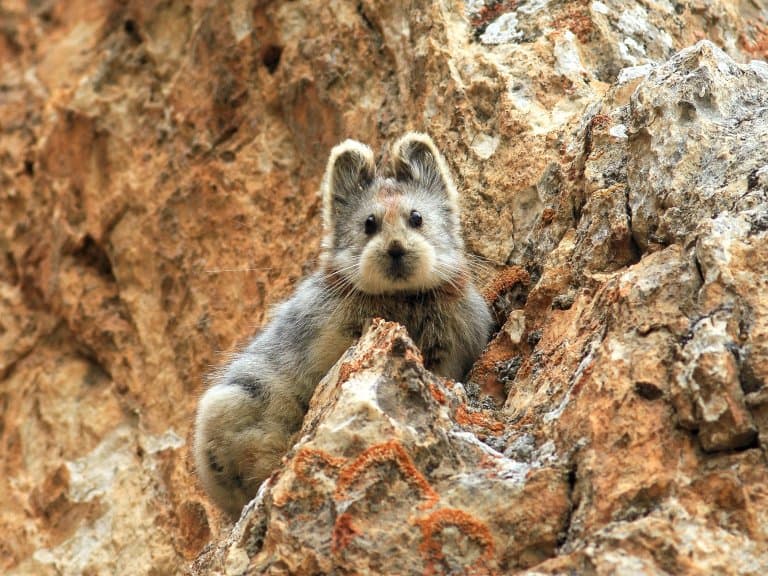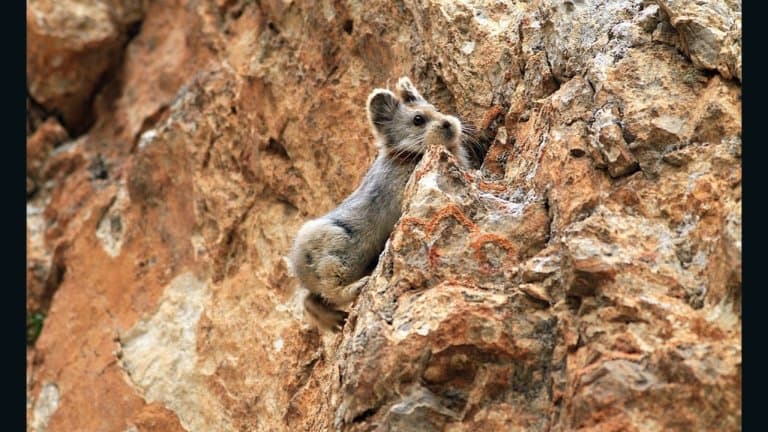Ili Pika Profile
There’s a magic rabbit up in the mountains of China, well adapted to the cold and so well hidden that it was only discovered by accident in the ‘80s.
This adorable little lagomorph made a big splash for a brief period in 2015 when it was rediscovered, photographed looking like a teddy bear and peering cutely at the photographer.
But the Ili Pika is a ‘rabbit’ on the run, and it has nowhere left to escape.

Ili Pika Facts Overview
| Habitat: | High altitude rocky outcrops |
| Location: | Chinese Tian Shan mountains |
| Lifespan: | Around 7 years |
| Size: | 20cm (8inches) |
| Weight: | 200g |
| Color: | Grey, white and tan |
| Diet: | Forbs and flower |
| Predators: | Raptors, foxes |
| Top Speed: | Unknown |
| No. of Species: | 1 |
| Conservation Status: | Endangered |
Ili pika is a pika, which is a small, mountain-dwelling mammal that resembles a rabbit, but with short, rounded ears and no tail.
They are usually native to Asia and North America, while Ili pika appears to only reside in the Tian Shan mountains of northwest Chinese province Xinjiangbeen.
If rabbits had rap names, the Ili Pika would be a good example. This indie artist lives at dizzying altitudes and keeps mostly to itself.
Sadly, its small range, slow reproduction and the encroaching effects of humanity and climate change are threatening to wipe it out within a single human lifetime of its discovery.
Interesting Ili Pika Facts
1. Magic Bunny
As if the name “Ili Pika” wasn’t cute enough, this tiny lagomorph has been nicknamed the magic bunny for its resemblance to a short-eared rabbit. But it’s not quite a rabbit at all.
Pikas are remarkably close to rabbits and hares (leporids) genetically, both occupying the same order, Lagomorpha, and are members of the second of the two families within the order. While they look like rodents, they have more teeth and are generally strict herbivores, while rodents will typically eat anything.
Pikas differ from other lagomorphs in their limbs and ears, and they do not hibernate. They’re often mostly solitary, as opposed to Leporids.

2. They’re cathemeral
Unlike most pika species who are diurnal, the Ili Pika seems to be okay foraging at any time of the day or night. The word for this is cathemeral, which refers to an irregular waking pattern.
This ability is generally thought to be a huge advantage to an animal and is generally restricted by predation as a limiting factor.
This means, while many animals could take this approach, the cost of, say, coming out at night and being eaten by a tiger, isn’t worth the salvage rights of any resources you might find. This, as we will see, might be a problem for the Ili pika.
3. From discovery to extinction in one generation
Ili pikas were discovered in 1983 by Weidong Li, who has since become its major advocate. Since its discovery, this pika’s population has declined significantly and Li has taken great lengths to promote the species in the mainstream to generate support for its protection.
Since the 2000s, Li has conducted field studies to assess the situation for Ili Pikas and witnessed first-hand its decline. Li predicts the species has dropped to below 1,000 individuals from 2,900-4,000 estimated from surveys in 1992.
Since that time, he’s managed to set up sanctuaries for the animal with government support. There are numerous reasons why the Ili pika is struggling, many if not all of which apply to similar animals all over the world, so understanding the plight of this rare animal can help us protect our own ecosystems too.
Unfortunately, the major drivers of its demise are hard to address, and it may well disappear before its discoverer. 1
4. They’re asocial
Ili pikas are, like many pika species, pretty much loners. They occupy small ranges and live in craggy outcrops by themselves.
This reduces the amount of resources they need but also creates a very dispersed population which can be easily displaced or interrupted.
This low population density not only impacts its reproductive rate, but also the ability of conservationists to help.
5. They’re slow to reproduce
The breeding cycle of the Ili Pika is long. Sadly, these magic rabbits don’t breed like rabbits, which makes recovery slow and vulnerable, even with external forces removed.
The exact nature of the Ili Pika’s breeding cycle is not fully understood, but inferences can be made by looking at similar species and from the rate of decline in the species over time.
6. They’re hard to find
Since they occupy small home ranges, often at altitudes of well over 2,800 meters, they’re not easy to come by.
Add to this their small size, penchant for hiding inside rocky outcrops and the fact that there aren’t many people actively seeking them, and you’ve got a recipe for Data Deficient status with the IUCN.
Thankfully, Li and his teams have done wonders for the species, having gathered the vast majority of data on them over more than three decades. Still, they’re most often surveyed after a lengthy horseback ride of hundreds of kilometres into the mountains – sometimes as high as 4000 meters.
As a result, samples include a shadow cast across a camera trap and one lightning-fast interaction between a pika and a researcher’s boot. Not exactly the strongest scientific evidence, but it’s the best available in many cases. 2
7. Sheep grazing is causing problems
One of the major causes for its decline comes from pastoral farmers. As human populations continue to grow, more land is taken up by housing and increased demand for meat pushes shepherds higher into the mountains.
These sheep not only compete for food with the pika as overgrazing devastates the plant life in its ranges, but they bring with them an ecosystem of predators like foxes that likely hunt the animal in ways it’s not evolved to avoid.
The pika’s natural habit of being out at all hours of the day and night then becomes a handicap as its foraging patterns begin to overlap with the hunting patterns of its predators. 3
8. But Climate change is the driver of their decline
As temperatures change in the pika’s range, so do the types of plants available to eat. And an increase in snowfall appears to be pushing the populations to higher elevations.
Ili pikas have now been found at altitudes of around 4,100 meters, and it’s thought that as they are pushed higher, they are overlapping even more with the pastoral activity that occupies the plateaus above their cliff faces.
These plateaus represent an upper bound to their potential habitats, representing the end of the line for their retreat from the effects of climate change.
This phenomenon has been documented in other mountain species both in the UK and in the US and could represent a fixed expiry date on this cold-loving lagomorph.
Ili Pika Fact-File Summary
Scientific Classification
| Kingdom: | Animalia |
| Phylum: | Chordata |
| Class: | Mammalia |
| Order: | Lagomorpha |
| Family: | Ochotonidae |
| Genus: | Ochotona |
| Species: | Ochotona Iliensis |
Fact Sources & References
- “The man who named, protected endangered Ili pikas in Xinjiang, NW China to retire after 35 years“, CGTN News.
- “CIRMOUNT“, Forest Service USDA
- Li Wei-Dong and Andrew T. Smith, “Dramatic decline of the threatened Ili pika Ochotona iliensis (Lagomorpha: Ochotonidae) in Xinjiang, China“, Sci-Hub.
